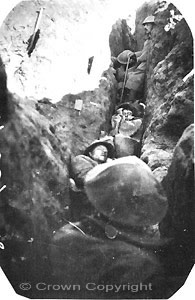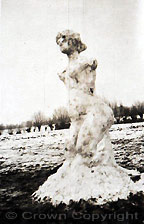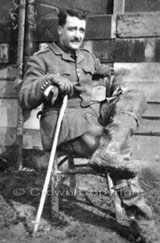Home | Subscribe | Advertise | Other Publications | Gallery | Obituaries | Contact |
|
|
|
||||||||
For some weeks during the summer of 1916 Captain Hugh Bayly was Medical Officer of the 1st Scots Guards. Much later he wrote about shell shock: “The term ‘shell shock’ was far too loose a term as used during the war to cover: (1) Shell concussion, with a more or less prolonged period of unconsciousness and almost certain damage to brain substance. (2) Shell neurasthenia, the result of nerve exhaustion after a prolonged period of strain and tension and lack of sleep. (3) Abnormal nerve reaction to the stimuli of explosions owing to a sensitive and highly strung nervous system. (4) A lack of normal nerve control in the face of danger, to which the ugly name of ‘cowardice’ is sometimes, but only sometimes, rightly given. All gallant men dread shell shock more than any other wound, for the simple reason that an extremely small percentage of the men returned with this disability may possibly include a few poltroons. There is no form of casualty that has my greater sympathy.”
Hugh Ross was born in 1884, the second son of Edward and Margaret Ross, whose home was in North Berwick, and grandson of Horatio Ross, prominent sportsman, prolific early photographer and godson of Admiral Nelson. His father died when Hugh was twelve. He then went to school at both Eton and Glenalmond before going to Sandhurst, from where he was commissioned into the Scots Guards in 1905. When the First World War broke out, the 1st Battalion Scots Guards were at Ramillies Barracks, Aldershot, and Ross went with them to France at the start, taking part in the Retreat from Mons, the Battle of the Marne and the early stages of the Battle of the Aisne. Later in that battle he became Signal Officer at Headquarters 1st Guards Brigade, his predecessor having been posted missing. In the middle of October the 1st Guards Brigade, among the last British troops still on the Aisne, travelled north and from 21st October were heavily involved in the 1st Battle of Ypres. Somewhere near the Menin Road on 4th November Hugh Ross was severely wounded by shrapnel in his left thigh and sent home to hospital.
It was not till February 1916 that Ross re-joined the 1st Scots Guards. Having spent the winter until then doing trench tours in the neighbourhood of Neuve Chapelle, the Guards Division had just moved north to the Ypres hinterland, but were not required immediately in the Salient. Consequently, among other diversions, each brigade spent nearly two weeks in very bracing conditions in tented camps outside Calais. While the 2nd Guards Brigade were there at the beginning of March, horse races were held on the beach. This, entitled the First Calais Spring Meeting, was the brainchild of Brigadier General John Ponsonby. In one race Hugh Ross was unplaced on his horse Fifinella. Soon afterwards in another camp near St Omer, where there was thick snow and no possibility of doing any worthwhile training, he and another company commander, Sir Iain Colquhoun of Luss, spent an afternoon building an enormous snowwoman, by the end of which they had given so much attention to the breasts that they had become ice. Sir Iain Colquhoun, likewise a pre-war regular in the 1st Battalion Scots Guards, had been through very much the same experiences initially, including being badly wounded during 1st Ypres, though he had recovered sooner and had been back out since October 1915. From late March to the end of July 1916, the Guards Division were either in the Ypres Salient or in reserve behind it. There were some very rough trench tours but others when little or nothing happened. However, with the front and immediate support positions overlooked almost everywhere, movement in daylight of any sort was extremely hazardous because of snipers, while shelling and mortaring could be turned on by the enemy at will; it was a very testing environment. Nevertheless, only a little way back from the line it was possible to relax and, in the reserve dug-outs in the canal bank just north of Ypres, Hugh Ross and Sir Iain Colquhoun spent one happy morning playing a set of pipes that had been sent up to them. Later, one evening in July, while the Brigade was in reserve, the Grenadier Guards Regimental Band performed at Brigade Headquarters and General Ponsonby threw an impromptu party with the guns firing in the Salient to the east and later, as it got dark, rockets and lights flying up into the night sky. Hugh Ross played the pipes as Sir Iain Colquhoun and Lieutenant Henry Dundas of the 1st Scots Guards and Lieutenants Allan Mackenzie and Robert Wolrige Gordon of the 3rd Grenadier Guards danced the Foursome Reel. Sir Iain Colquhoun told his wife that he had also danced twice with the Prince of Wales.
Next the Guards Division moved south and for a short while rested and waited out to the west of the Somme battlefield, though there were a few trench tours as well. It was obvious that something more serious was coming and on 9th September the 1st Scots Guards moved up towards the front line much further east and camped in Happy Valley, near Fricourt, where they first saw tanks. Further still to the east, during that day and the next, the 16th Irish Division captured most of Ginchy and then had to be relieved in a situation which was far from stable. The 3rd Guards Brigade went up there on 10th September and there was continuous heavy fighting before some of the 2nd Guards Brigade became involved from the 12th, including two companies from the 1st Scots Guards, Right Flank under Hugh Ross being one of them. They went into support trenches behind Ginchy where they were much shelled and there were many casualties. 15th September became the day for the biggest attack on the Somme, both British and French, since 1st July, concentrating on the eastern and southern parts of the battlefield. The situation at Ginchy was improved, but cramped and far from ideal, as the Guards Division prepared for a two brigade attack northeast towards Lesboeufs. The 2nd Guards Brigade were to attack on the right but it was extremely difficult to brief and resupply those already forward near Ginchy. The start line was more or less secure, but behind it the congestion was severe and consequently, soon after the attack began, the waves of men became mixed up. The 3rd Grenadiers were the leading battalion on the right with the 1st Scots Guards following them. Immediately the enemy retaliated. Forward of their main front line trench they had prepared improvised trench lines in shellholes, the existence of which was unknown to the British. There was heavy artillery fire and off to the right machine guns opened up in enfilade from outside the divisional boundary (the same was happening to the 1st Guards Brigade on the left). In spite of all this, the Guards Division took the enemy front line and in places a bit more. Everywhere was noise and confusion. At one stage Hugh Ross and Sir Iain Colquhoun were together when there was another burst of machine gun fire and they and five men jumped into a shellhole, where they were joined by an officer from the 2nd Guards Brigade Machine Gun Company. A soldier who moved to make space for him was immediately shot dead. They were in the shellhole for over an hour, at the end of which only Sir Iain Colquhoun was unwounded. Two of the men had been sniped, shrapnel had killed the other two and wounded the other officer and Hugh Ross had been slightly wounded twice and gone ‘off his head’.
For some months he remained the other side of the Channel but by the summer of 1917 was commanding Right Flank back at Ypres. In June Right Flank were manning reserve trenches at Elverdinghe near Brigade Headquarters, where Lieutenant Dundas was now the Bombing and Intelligence Officer. Captain Oliver Lyttleton, a Grenadier, remembered them being ‘in some dug-outs along the garden wall of the Château. During the whole of one afternoon and early evening this part of the grounds was shelled with great intensity, and several men were buried and had to be dug out, whilst all had narrow escapes. Hugh, at this time, was suffering from fever and strain, and few in his condition would have been still at duty. When the shelling was over he came into Brigade Headquarters covered with brick dust, exhausted, and nearly ‘through’. He was asked to dinner. Henry was in particularly good form, and his high spirits were so infectious that by the end of dinner Hugh had recovered. The irrepressible Henry must of course begin Scotch songs…they started to dance a reel and give out the chorus with the utmost vigour. Outside the evening shells were homing like wild duck into the ponds and garden of the house, whilst inside Hugh and Henry beat up the singing to a frenzy, and eventually collapsed perspiring and laughing on the floor’.
Early in September, Lieutenant Colonel Jack Stirling, who commanded the 2nd Scots Guards, was slightly gassed, needing treatment, and then went on sick leave to England. So Hugh Ross was commanding on 27th September when the Guards Division crossed the Canal du Nord and captured the Hindenburg Support Line north of Flesquières. For this, starting early in the morning, the brigades followed each other forward in stages. The first stage went well, but the projected second and third stages were hampered and disrupted by very heavy machine gun fire from around Graincourt, outside the left divisional boundary, which could only be suppressed once the neighbouring troops drew level. This was not until well into the afternoon. Exactly what happened to the 2nd Scots Guards was not spelled out in subsequent reports but when the 3rd Guards Brigade moved forward after the other two had advanced by the time that the 3rd Grenadiers had reached Flesquières, with the 1st Welsh Guards following them, both had lost contact with the 2nd Scots Guards who should have been on their left. While the other two stormed on along the north side of the Flesquières Ridge towards Premy Chapel, the 2nd Scots Guards, though complying with their orders not to move until those to their left were able to do so, simply occupied captured trenches north of Flesquières. It did not help that the brigade commander had been killed earlier and that quite separately there was a prolonged brigade communications breakdown. |
||||||||
|
||||||||





